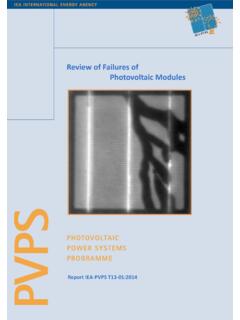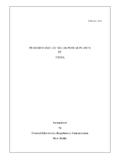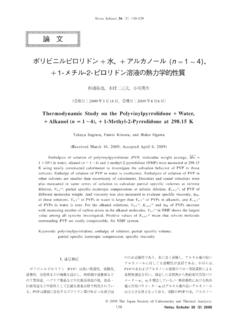Transcription of Review of Failures of Photovoltaic Modules - IEA PVPS
1 Review of Failures of Photovoltaic Modules Report IEA- pvps T13-01:2014. Ultraviolet fluorescence image of a cracked solar cell in a Photovoltaic module . Courtesy of Marc K ntges, Institute for Solar Energy Research Hamelin. INTERNATIONAL ENERGY AGENCY. Photovoltaic POWER SYSTEMS PROGRAMME. Performance and Reliability of Photovoltaic Systems Subtask : Review of Failures of Photovoltaic Modules IEA pvps Task 13. External final report IEA- pvps . March 2014. ISBN 978-3-906042-16-9. Primary authors: Marc K ntges, Institute for Solar Energy Research Hamelin, Emmerthal, Germany Sarah Kurtz, Corinne Packard, National Renewable Energy Laboratory, Golden, CO, USA.
2 Ulrike Jahn, T V Rheinland Energie und Umwelt GmbH, Cologne, Germany Karl A. Berger, Austrian Institute of Technology GmbH, Energy Department, Vienna, Austria Kazuhiko Kato, National Institute of Advanced Industrial Science and Technology, Tsukuba, Japan Thomas Friesen, SUPSI ISAAC, Canobbio, Switzerland Haitao Liu, Institute of Electrical Engineering, Chinese Academy of Sciences, Beijing, China Mike Van Iseghem, Electricit de France, EDF R&D, Moret-sur-Loing, France Contributing authors: John Wohlgemuth, David Miller, Michael Kempe, Peter Hacke National Renewable Energy Laboratory, Golden, CO, USA.
3 Florian Reil, Nicolas Bogdanski, Werner Herrmann T V Rheinland Energie und Umwelt GmbH, Cologne, Germany Claudia Buerhop-Lutz The Bavarian Centre for Applied Energy Research, W rzburg, Germany Guillaume Razongles Institut National de l'Energie Solaire, INES-CEA, Le Bourget-du-Lac, France Gabi Friesen, SUPSI ISAAC, Canobbio, Switzerland This report is supported by Austrian Federal Ministry for Transport, Innovation and Technology (BMVIT) under FFG contract No. 828105, Chinese Academy of Sciences (CAS), German Federal Ministry for Economic Affairs and Energy under Contract (BMWi), Swiss Federal Office of Energy (SFOE).
4 And Department of Energy under Contract No. DE-AC36-08-GO28308 with the National Renewable Energy Laboratory (NREL). Table of Contents 1 Foreword .. 1. 2 Executive summary .. 2. 3 Introduction .. 4. 4 Definitions .. 10. Definition of a PV module 10. PV module Failures excluded by definition .. 10. Important PV module Failures due to external 12. Clamping .. 12. Transport and installation .. 13. Quick connector failure .. 14. 14. Definition of safety failure and safety 16. Definition of power loss failure and power loss categories.
5 17. Definition of a defect .. 18. Definition of PV module parts .. 18. 5 Basics of measurement methods used to identify 20. Visual inspection .. 20. Visual inspection in accordance with IEC PV standards .. 21. Documentation of visual Failures in the field .. 23. I-V curve .. 26. Introduction of the important I-V curve parameters .. 26. Series resistance and shunt resistance .. 27. 28. Effect of Failures on the I-V curve .. 29. Thermography .. 33. Thermography under steady state conditions .. 33. Pulse thermography .. 36. Lock-in thermography.
6 37. 41. UV fluorescence .. 47. Signal transmission method .. 49. 6 Failures of PV Modules .. 53. Review of Failures found in all PV Modules .. 55. Delamination .. 55. Back sheet adhesion 56. I. Junction box failure .. 58. Frame breakage .. 58. Review of Failures found in silicon wafer-based PV Modules .. 61. EVA discolouration .. 61. Cell 62. Snail 67. Burn marks .. 71. Potential induced degradation .. 73. Disconnected cell and string interconnect ribbons .. 82. Defective bypass diode .. 85. Review of Failures found in thin-film Modules .
7 88. Micro arcs at glued connectors .. 88. Shunt hot spots .. 89. Review of specific Failures found in CdTe thin-film PV Modules .. 92. Front glass breakage .. 93. Back contact degradation .. 94. 7 Adapting testing methods to failure mechanism for PV 96. Mechanical loads caused by 96. Determination of resonance frequencies of single PV Modules .. 97. Transport and environmental testing of silicon wafer-based PV Modules in a shipping stack .. 97. Transport testing of single silicon wafer-based PV Modules .. 99. Mechanical loads caused by snow.
8 104. Testing for UV degradation of PV Modules .. 106. UV preconditioning for PV Modules .. 107. Performance degradation of PV Modules .. 108. Ammonia Testing .. 110. Tests performed on crystalline Si glass/foil PV Modules .. 112. Tests performed on non-glass 113. Testing for potential induced degradation of crystalline silicon PV Modules . 114. Extended IEC testing in the 116. Test results from extended testing .. 118. Accelerated testing and field experience .. 121. 8 Conclusions .. 123. ANNEX A: module condition checklist.
9 127. II. 1 Foreword The International Energy Agency (IEA), founded in November 1974, is an autonomous body within the framework of the Organization for Economic Co- operation and Development (OECD) which carries out a comprehensive programme of energy co-operation among its member countries. The European Union also participates in the work of the IEA. Collaboration in research, development and demonstration of new technologies has been an important part of the Agency's Programme. The IEA Photovoltaic Power Systems Programme ( pvps ) is one of the collaborative R&D Agreements established within the IEA.
10 Since 1993, the pvps participants have been conducting a variety of joint projects in the application of Photovoltaic conversion of solar energy into electricity. The mission of the IEA pvps programme is: To enhance the international collaborative efforts which facilitate the role of Photovoltaic solar energy as a cornerstone in the transition to sustainable energy systems. The underlying assumption is that the market for PV systems is rapidly expanding to significant penetrations in grid-connected markets in an increasing number of countries, connected to both the distribution network and the central transmission network.










